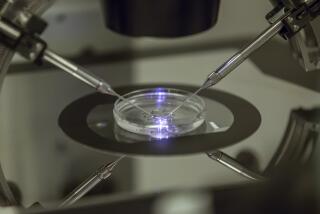90% Success Rate Shown in Fertilization
- Share via
Women interested in artificial insemination but concerned about their chances of success should be aware of a new study concluding that overall rates of conception exceed 90% by the 12th fertilization attempt.
While these odds are generally optimistic, reports a Boston research team, a variety of risk factors can substantially reduce prospects for success--with two or more of the risk factors port1701733481pregnancy. Factors with especially negative overtones are 35 or older and a history of endometriosis.
Promising New Method
But for women who are unable to become pregnant with traditional insemination techniques--in which donor sperm is introduced into the vagina--a new method in which sperm is placed directly into the Fallopian tubes may be a promising alternative, according to a separate report by a doctor at the University of North Carolina.
In the Boston study, reported in the journal Obstetrics and Gynecology, Drs. John Yeh and Machelle Seibel studied effectiveness rates of artificial insemination in an attempt to clarify prospects for success. Those prospects have varied greatly in previous research.
Focusing on 108 women, the researchers found that 47% had become pregnant by the third treatment cycle and 92% were pregnant by the 12th. But these optimistic overall results were tempered by observations about the influence of risk factors.
Especially significant was the presence of endometriosis; only 25% of women with the condition achieved pregnancy. Women older than 35 had a 90% failure rate.
Other risk factors that may reduce prospects of success in artificial insemination included the presence of other female-related infertility problems; no previous pregnancy; use of cycle-stimulating medications, and a lack of success with artificial insemination with sperm supplied by the husband (as opposed to sperm from another man).
Using the new Fallopian-tube technique, Dr. Gary Berger reported on results of a test on 20 women referred to him because of persistent infertility problems, including repeated failure to conceive through traditional artificial insemination. Berger described his research in the journal Fertility and Sterility.
Two live births eventually resulted, with no treatment exceeding three insemination cycles--or a rate that compares favorably with artificial insemination in general under the same conditions of repetition.
Volleyball Injuries
Though volleyball is enjoyed by millions of people, sports medicine researchers have devoted surprisingly little attention to the game’s injury problems, reports a study team that finds that volleyball has a high risk of knee and ankle injury.
Reporting in the journal Physician and Sportsmedicine, researchers from the Institute for Athletic Medicine in Edina, Minn., examined the injuries suffered by 106 players.
Where previous studies had found volleyball to be a comparatively benign sport in terms of injury potential, the Minnesota researchers found the combined jumping-twisting-landing maneuver central to making a volleyball shot brought with it a severe risk of knee injury. Ankle injuries were also frequent.
Proportionally, more men were hurt, but injured men tended by be older--30 to 39--than women, who were primarily 15 to 24. Researchers attributed this to the rise of high school and college women’s volleyball programs.
Knees accounted for 57% of volleyball injuries, and 97% of those required surgery. Knee-injury treatment costs averaged $6,832.
“The estimated costs of volleyball injuries, together with the potential for long-term disability, appear to constitute a significant problem,” the Minnesota researchers concluded.





